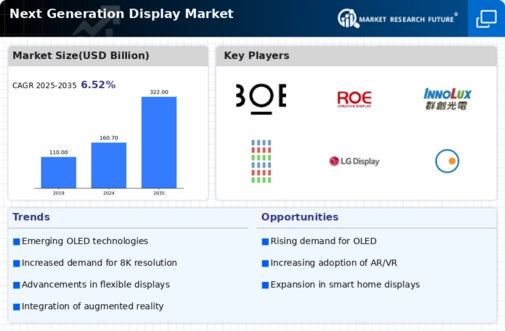Increased Adoption of Smart Displays
The integration of smart features into display technologies is transforming the Next Generation Display Market. Smart displays, equipped with internet connectivity and interactive capabilities, are gaining traction in both consumer and commercial sectors. As of October 2025, the market for smart displays is anticipated to expand rapidly, with projections indicating a growth rate of around 20 percent annually. This surge is largely attributed to the increasing demand for connected devices and the rise of smart home ecosystems. Additionally, businesses are leveraging smart displays for advertising and information dissemination, enhancing customer engagement. The convergence of display technology with artificial intelligence and machine learning further enhances the functionality of these devices, positioning the Next Generation Display Market for substantial growth.
Growth in Automotive Display Applications
The automotive sector is emerging as a significant driver for the Next Generation Display Market. With the increasing integration of advanced display technologies in vehicles, such as heads-up displays and infotainment systems, the demand for high-quality displays is on the rise. As of October 2025, the automotive display market is projected to grow at a compound annual growth rate of approximately 18 percent. This growth is fueled by the trend towards electric and autonomous vehicles, which require sophisticated display solutions for enhanced user interfaces and safety features. Additionally, the incorporation of augmented reality in automotive displays is expected to revolutionize the driving experience. As manufacturers invest in innovative display technologies, the Next Generation Display Market is poised for substantial expansion.
Rising Demand for High-Resolution Displays
The demand for high-resolution displays is a key driver in the Next Generation Display Market. As consumers increasingly seek immersive experiences, the need for 4K and 8K resolution displays is on the rise. This trend is particularly evident in sectors such as gaming, entertainment, and professional visualization, where high-definition content is becoming the norm. By October 2025, the market for high-resolution displays is expected to grow significantly, with estimates suggesting a compound annual growth rate of over 15 percent. This growth is fueled by advancements in content creation and streaming technologies, which are making high-resolution content more accessible. Consequently, manufacturers are compelled to innovate and enhance their offerings to meet consumer expectations, thereby driving the Next Generation Display Market.
Sustainability and Eco-Friendly Initiatives
Sustainability is becoming a pivotal factor in the Next Generation Display Market. As environmental concerns rise, manufacturers are increasingly focusing on eco-friendly production processes and materials. The shift towards sustainable practices is evident in the development of displays that utilize less energy and are made from recyclable materials. By October 2025, it is estimated that the market for sustainable display technologies will witness a notable increase, driven by consumer preference for environmentally responsible products. This trend is further supported by regulatory pressures and initiatives aimed at reducing electronic waste. Companies that prioritize sustainability are likely to gain a competitive edge, as consumers become more discerning about the environmental impact of their purchases, thereby influencing the dynamics of the Next Generation Display Market.
Technological Advancements in Display Technology
The Next Generation Display Market is currently experiencing a surge in technological advancements, particularly with the development of OLED and MicroLED technologies. These innovations offer superior image quality, enhanced color accuracy, and improved energy efficiency compared to traditional LCD displays. As of October 2025, the market for OLED displays is projected to reach approximately 30 billion USD, driven by their adoption in smartphones, televisions, and automotive displays. Furthermore, advancements in flexible display technology are enabling new applications in wearables and foldable devices, which could potentially reshape consumer electronics. The continuous evolution of display technology not only enhances user experience but also drives competition among manufacturers, thereby propelling the Next Generation Display Market forward.
















